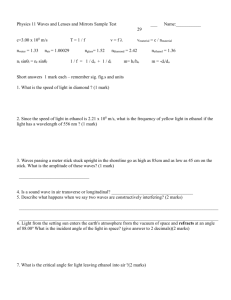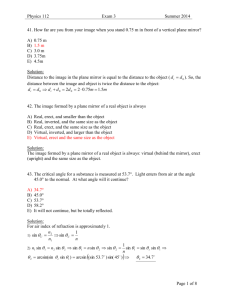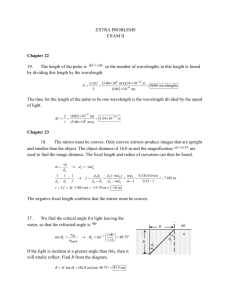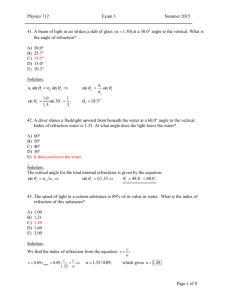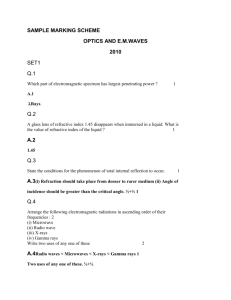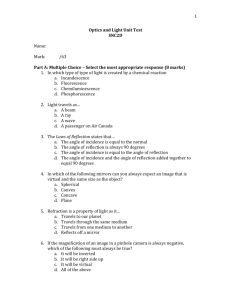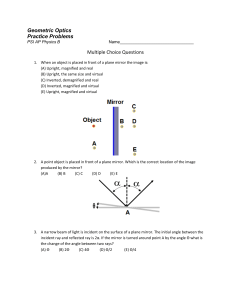exam3_solutions
advertisement
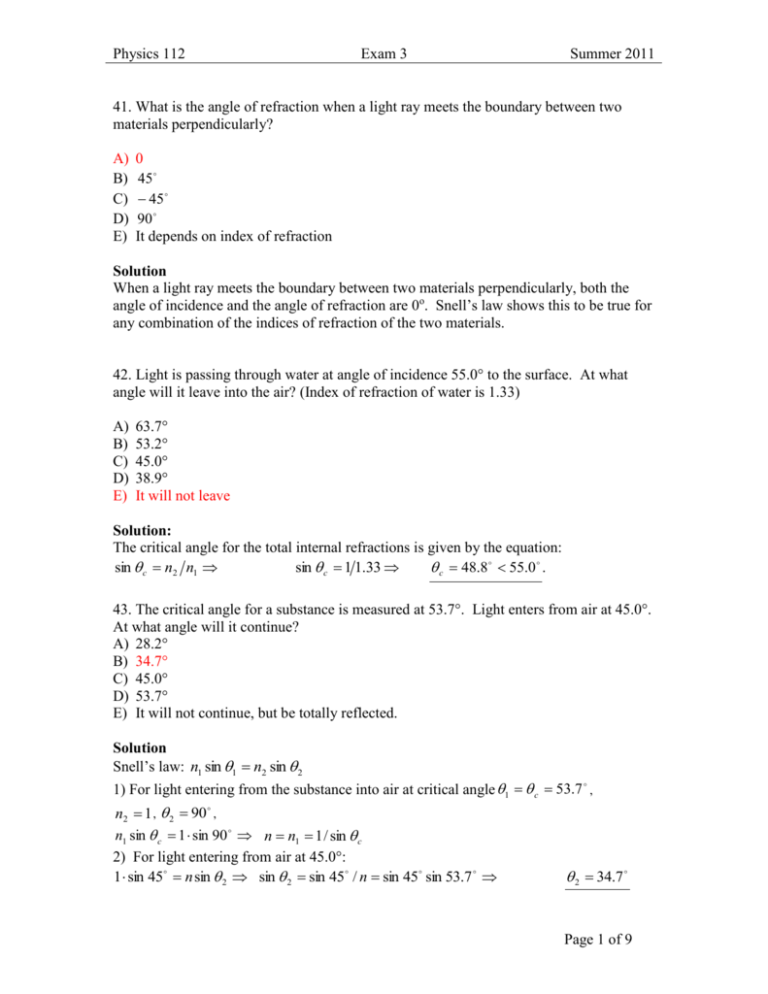
Physics 112 Exam 3 Summer 2011 41. What is the angle of refraction when a light ray meets the boundary between two materials perpendicularly? A) B) C) D) E) 0 45 45 90 It depends on index of refraction Solution When a light ray meets the boundary between two materials perpendicularly, both the angle of incidence and the angle of refraction are 0o. Snell’s law shows this to be true for any combination of the indices of refraction of the two materials. 42. Light is passing through water at angle of incidence 55.0° to the surface. At what angle will it leave into the air? (Index of refraction of water is 1.33) A) B) C) D) E) 63.7° 53.2° 45.0° 38.9° It will not leave Solution: The critical angle for the total internal refractions is given by the equation: c 48.8 55.0 . sin c n2 n1 sin c 1 1.33 43. The critical angle for a substance is measured at 53.7°. Light enters from air at 45.0°. At what angle will it continue? A) 28.2° B) 34.7° C) 45.0° D) 53.7° E) It will not continue, but be totally reflected. Solution Snell’s law: n1 sin 1 n2 sin 2 1) For light entering from the substance into air at critical angle 1 c 53.7 , n2 1 , 2 90 , n1 sin c 1 sin 90 n n1 1 / sin c 2) For light entering from air at 45.0°: 1 sin 45 n sin 2 sin 2 sin 45 / n sin 45 sin 53.7 2 34.7 Page 1 of 9 Physics 112 Exam 3 Summer 2011 44. An object is located 2.6 m in front of a plane mirror. The image formed by the mirror appears to be A) B) C) D) E) 1.3 m in front of the mirror on the mirror's surface 1.3 m behind the mirror's surface 2.6 m behind the mirror's surface 2.6 m in front of the mirror Solution For plane mirror: d i d o 45. A single convex spherical mirror produces an image which is A) B) C) D) E) Always virtual and upright Always virtual and inverted Always real and upright Always real and inverted Real only if the object distance is less than focal distance. Solution From the ray diagram follows: “Always virtual and upright”. 46. A mirror at an amusement park shows an upright image of any person who stands 1.4m in front of it. If the image is three times the person’s height, what is the radius of curvature? A) B) C) D) E) 2.2 m 3.2 m 4.2 m 5.2 m 6.2 m Solution We find the image distance from the magnification: di h d 3 , m i i ; ho do 1.4 m which gives di 4.2 m. We find the focal length from 1 1 1 1 1 1 , ; d o di f 1.4 m 4.2 m f which gives f 2.1m. The radius of the concave mirror is r 2 f 2 2.1m 4.2m. Page 2 of 9 Physics 112 Exam 3 Summer 2011 47. A negative magnification for a mirror means A) The image is inverted, and the mirror is concave B) The image is inverted, and the mirror is convex. C) The image is inverted, and the mirror may be concave or convex D) The image is upright, and the mirror is convex E) The image is upright, and the mirror may be concave or convex Solution h m i Negative m means that hi and h0 have opposite signs – image is inverted. ho For convex mirror image is always upright. 48. A negative magnification for a lens means A) The image is inverted, virtual and the lens is converging B) The image is inverted, real and the lens is converging C) The image is, inverted, virtual and the lens is diverging D) The image is inverted, real and the lens is diverging E) The image is upright, real and the lens is diverging Solution h m i Negative m means that hi and h0 have opposite signs– image is inverted. ho For diverging lens image is always upright. 49. When a light wave enters into a medium of different optical density, A) Its speed and frequency change B) Its speed and wavelength change C) Its frequency and wavelength change D) Its speed, frequency, and wavelength change E) Its speed change, but frequency and wavelength remain unchanged Solution Wave frequency, f is determent by wave source. Speed, v is a characteristic of the medium, and wavelength v / f . Page 3 of 9 Physics 112 Exam 3 Summer 2011 50. Monochromatic light falls on two very narrow slits 0.048 mm apart. Successive fringes on a screen 5.00 m away are 6.5 cm apart near the center of the pattern. Determine the wavelength of the light. A) 4.2 10 7 m B) 5.2 10 7 m C) 6.2 10 7 m D) 7.2 10 7 m E) 8.2 10 7 m Solution For constructive interference, the path difference is a multiple of the wavelength: d sin m , m 0, 1, 2, 3, ... . We find the location on the screen from y L tan . For small angles, we have sin tan , which gives m mL y L . d d For adjacent fringes, m 1, so we have L m y ; d 5.00 m 1 0.065m , which gives 6.2 107 m. 3 0.048 10 m 51. Monochromatic light falls on a slit that is 2.60 10 3 mm wide. If the angle between the first dark fringes on either side of the central maximum is 30.0° (dark fringe to dark fringe), what is the wavelength of the light used? A) B) C) D) E) 450 nm 511 nm 585 nm 627 nm 673 nm Solution The angle from the central maximum to the first minimum is 1 = 30.0° /2 =15.0° We find the wavelength from D sin m m D sin 1 2.60 10 6 msin 15.0 , which gives 6.73 10 7 m 673nm Page 4 of 9 Physics 112 Exam 3 Summer 2011 52. In order to obtain a good single slit diffraction pattern, the slit width could be: A) /100 B) /10 C) D) 10 E) 100 Solution: D sin m m m 1,2,3,... If D 10 , than sin m 0.1m and one can observe several dark and bright fringes. 53. A 3500 -line cm grating produces a third-order fringe at a 28.0° angle. What wavelength of light is being used? A) B) C) D) E) 421 nm 447 nm 502 nm 631 nm 680 nm Solution We find the wavelength from d sin m; d sin / m 1 2 10 m / cm sin 28.0 / 3 , which gives 4.47 107 m 447nm. 3500lines / cm 54. The separation between adjacent maxima in a double-slit interference pattern using monochromatic light is A) greatest for red light B) greatest for green light C) greatest for blue light D) the same for all colors of light E) greatest for red light or for blue light depending on the distance between the slits Solution: Conditions for constrictive interference: d sin m m . For given index m, angle m is increasing with increasing wavelength . Maximum value of m is for the maximum value of , which is for red light. Page 5 of 9 Physics 112 Exam 3 Summer 2011 55. A lens appears greenish yellow ( 570 nm is strongest) when white light reflects from it. What minimum thickness of coating (n 1.25) do you think is used on such a glass (n 1.52) lens? A) B) C) D) E) 570 nm 512 nm 450 nm 321 nm 228 nm Solution There are phase shifts on both surfaces: air-film and film-glass. For constructive interference we have: 2t m film m / n film , and tmin 2nfilm 570nm 2 1.25 228nm. 56. A ray of light is refracted through three different materials. Rank the materials according to their index of refraction. A) n1 n2 n3 B) n1 n3 n2 C) n2 n1 n3 D) n2 n3 n1 E) n3 n2 n1 Solution: By looking at the direction and the relative amount that the light rays bend at each interface, we can infer the relative sizes of the indices of refraction in the different materials (bends toward normal = smaller n material to larger n material; bends away from normal = larger n material to smaller n material). From the first material to the second material the ray bends toward the normal, thus n1 < n2. From the second material to the third material the ray bends away from the normal, thus n2 > n3. Careful inspection shows that the ray in the third material does not bend back away from the normal as far as the ray was in the first material, thus and n1 < n3. Thus, the overall ranking of indices of refraction is: n1 < n3 < n2. Page 6 of 9 Physics 112 Exam 3 Summer 2011 57. What is Brewster’s angle for a diamond submerged in water if the light is hitting the diamond (n 2.42 ) while traveling in the water (n =1.33)? A) B) C) D) E) 33° 41° 52° 61° 72° Solution Because the light is coming from water to diamond, we find the angle from the vertical from n 2.42 tan p diamond 1.82, which gives p 61.2. nwater 1.33 58. A person has a far point of 14 cm. What power glasses would correct this vision if the glasses were placed 2.0 cm from the eye? A) B) C) D) E) +2.0 -2.0 -4.6 -6.5 -8.3 Solution With the glasses, an object at infinity would have its image 14 cm from the eye or 14cm 2cm 12cm from the lens; di 12cm. P 1 1 1 1 1 8.3D f do di 0.12m 59. A small insect is placed 5.0 cm from a 6.00 -cm-focal-length lens. Calculate the angular magnification. A) B) C) D) E) 1.2 2.4 4.1 5.0 6.0 Solution Magnification is M ' 25cm 25cm 5.0 d0 5.0cm Page 7 of 9 Physics 112 Exam 3 Summer 2011 60. An astronomical telescope has an objective with focal length 85 cm and a 35-D eyepiece. What is the total magnification? A) B) C) D) E) -15 -20 -30 -35 -41 Solution We find the focal length of the eyepiece from the power: fe 1 1 1 1 m 1 P 35D 35m 35 The magnification of the telescope is given by M fo f o P 0.85m 35m 1 29.75 fe Page 8 of 9 Physics 112 Exam 3 Summer 2011 Record Sheet You may fill in this sheet with your choices, detach it and take it with you after the exam for comparison with the posted answers 41 A) 0 51 E) 683 nm 42 E) It will not leave 52 D) 10 43 B) 34.7° 53 B) 447 nm 44 D) 2.6 m behind the mirror's surface 54 A) greatest for red light 45 A) Always virtual and upright 55 E) 228 nm 46 C) 4.2 m 56 B) n1 n3 n2 47 A) The image is inverted, and the mirror is concave 57 D) 61° 48 B) The image is inverted, real and the lens is converging 49 B) Its speed and wavelength change 58 E) -8.3 50 C) 6.2 10 7 m 60 C) -29 59 D) 5.0 Page 9 of 9
